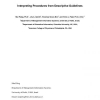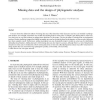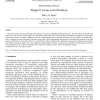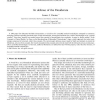JBI
2006
15 years 18 days ago
2006
Bioinformatics is a dynamic research area in which a large number of algorithms and programs have been developed rapidly and independently without much consideration so far of the...
72
Voted
JBI
2006
15 years 18 days ago
2006
71
Voted
JBI
2006
15 years 18 days ago
2006
Concerns about the deleterious effects of missing data may often determine which characters and taxa are included in phylogenetic analyses. For example, researchers may exclude ta...
79
Voted
JBI
2006
15 years 18 days ago
2006
Throughout history, philosophers, scientists, and other scholars have named and organized the salient elements of the world. These efforts have led to conceptualizations that diff...
112
Voted
JBI
2006
15 years 18 days ago
2006
Numerous metrics have been developed that attempt to assess the reliability of phylogenetic trees. Several of these commonly used measures of tree and tree branch support are desc...
96
Voted
JBI
2006
15 years 18 days ago
2006
Systematic analyses are included as integral parts of bioinformatic analysis. The use of phenetic and phylogenetic trees in many of the newer areas of biology create a need for bi...
94
Voted
JBI
2006
15 years 18 days ago
2006
A 1998 paper that delineated desirable characteristics, or desiderata for controlled medical terminologies attempted to summarize emerging consensus regarding structural issues of...
107
Voted
JBI
2006
15 years 18 days ago
2006
The goal of referent tracking is to create an ever-growing pool of data relating to the entities existing in concrete spatiotemporal reality. In the context of Electronic Healthca...
JBI
2006
15 years 18 days ago
2006
Molecular evolutionary studies provide a means of investigating how cells function and how organisms adapt to their environment. The products of evolutionary studies provide medic...
100
Voted
JBI
2006
15 years 18 days ago
2006
Domain reference ontologies represent knowledge about a particular part of the world in a way that is independent from specific objectives, through a theory of the domain. An exam...




